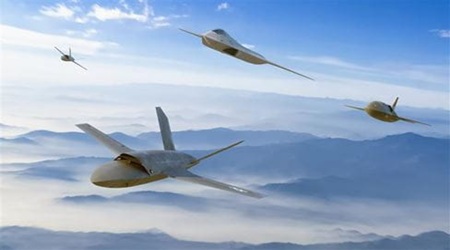
TUCSON, AZ (Sept. 30, 2025) — Raytheon, an RTX (NYSE: RTX) business with major missile operations in Tucson, has expanded its collaboration with Avio USA to accelerate production of the Mk 104 dual-thrust rocket motor used across the Standard Missile franchise. A new purchase order of up to $26 million funds continued engineering through Critical Design Review, buys long-lead qualification materials, and builds second-source capacity for key solid-rocket components—all aimed at hardening the supply chain and increasing throughput.
“This purchase order represents an important step in expanding our supply chain to ensure the resilience and availability of the Mk 104 rocket motor,” said Barbara Borgonovi, president of Naval Power at Raytheon. Avio USA—the U.S. subsidiary of Italy’s Avio S.p.A., led by VADM (Ret.) James Syring—previously completed System Requirements and Preliminary Design Reviews with Raytheon. Avio CEO Giulio Ranzo said the company will continue supporting SRM engineering, materials characterization, lab and fire testing, sourcing, and motor integration as the program advances toward qualification and production.
RTX propulsion portfolio: air-breathing and solid rockets
RTX made two propulsion announcements on Sept. 24, 2025, underscoring parallel progress across its businesses. Pratt & Whitney reported completion of critical tests on its small turbofan engine family (air-breathing propulsion), while Raytheon detailed steps to accelerate Mk 104 dual-thrust rocket motor production (solid-rocket propulsion). Together, the updates highlight RTX’s push on both sides of the propulsion spectrum—jet engines and rocket motors—supporting a broad range of air and missile systems.
Parallel progress: StormBreaker, Stinger, and more
In the same week, Raytheon highlighted rapid progress on a ground-launched variant of StormBreaker—a network-enabled smart weapon designed for adverse-weather targeting at sea or on land. Leveraging components from the air-launched version (fielded on F-15E and F/A-18E/F, with integration underway on F-35A/B/C), Raytheon says it went from concept to test flight in under 50 days, reaching ~20,000 feet during a spring test in the Mojave Desert. The company plans to accelerate development and continue testing through 2025.
Raytheon also booked a string of contract awards centered on Arizona production, led by a $576.6 million U.S. Army award for Stinger missiles, equipment, and support services. Additional actions across Navy and Air Force programs underscore sustained demand for Tucson-built air- and missile-defense systems:
-
$160.9M (Navy, Sept. 26) — Engineering to develop/qualify a second-source SRM assembly and WDU-17/B warhead supporting AIM-9X; includes partial production/options. Work largely in Tucson; completion Sept. 2029.
-
$14.6M (Navy, Sept. 26) — Design-agent/engineering for Rolling Airframe Missile (RAM); completion Mar. 2028 (German funding predominant).
-
$11.6M (Navy, Sept. 26) — Spares for RAM Seeker Head Assemblies and GMRP requirements; Tucson/Tempe; completion Jun. 2027.
-
$85.2M (USAF, Sept. 26) — MALD/MALD-J sustainment services; Tucson; completion Sept. 25, 2030.
-
$75.3M (Navy, Sept. 25) — Options/funding for Standard Missile program; work in Tucson/other sites; completion Mar. 2030.
-
$20.2M (Navy, Sept. 25) — Capacity enhancements for Tomahawk All-Up Round production; Tucson-weighted; completion Mar. 2028.
-
$271.4M (Army, Sept. 22) — Production of TOW (including TOW Obsolescence & Safety 2B variant); Tucson; completion Feb. 29, 2028.
-
$216.4M (Navy, Sept. 18) — Special tooling/test equipment to expand SM-6 All-Up Round capacity; Tucson/Gilbert; completion Sept. 2029.
-
$43.2M (Navy, Sept. 17) — SM-6 steering control section redesign; Tucson; completion Nov. 2027.
-
$7.7M (Navy, Sept. 11) — RAM design-agent/engineering support; Tucson; completion Mar. 2028 (FMS: Japan, Canada).
-
$760M (USAF, Sept. 9) — AMRAAM support with extensive FMS (Canada, Taiwan, Sweden, Czech Republic, Korea, Kuwait, Japan, Finland, U.K., Portugal, Italy, Netherlands, Saudi Arabia, Norway, Belgium, Australia, Turkey, Spain, Lithuania); Tucson; completion Sept. 7, 2030.
-
$205.1M (Navy, Sept. 5) — Phalanx CIWS (Mk 15) upgrades/overhauls; portions in Tucson/Tempe; completion Jan. 2029.
-
$95.7M (Navy, Sept. 4) — Tomahawk nav/comm antenna kits (recert & production) for U.S. services and FMS; significant Tucson work; completion Apr. 2029.
-
$380M (USMC, Sept. 2) — Medium Range Intercept Capability (MRIC); Tucson; completion Aug. 28, 2028.
-
$57.5M (Navy, Aug. 29) — Non-recurring engineering to redesign Tomahawk DSMAC; Tucson; completion Dec. 2028.
-
$13.5M (Navy, Aug. 29) — Components for future Tomahawk production amid obsolescence; Tucson; completion Apr. 2028.
Why it matters for Arizona
The Mk 104 second-source push with Avio USA and the fresh wave of missile awards extend a multi-year surge in Raytheon’s Arizona footprint—from propulsion and seeker subsystems to full-up missile integration. With supply-chain resilience now a top priority, Tucson’s role as a production and engineering hub continues to grow across Standard Missile, Tomahawk, AMRAAM, AIM-9X, RAM, Stinger, TOW, MRIC, and StormBreaker programs.
PHOTO: Concept rendering of low-observable ‘loyal wingman’ drones operating in a networked formation.


